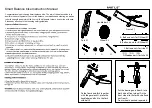
5
calibrated torque wrench. A professional bicycle mechanic with a torque wrench should
torque the fasteners on your bicycle. If you choose to work on your own bicycle, you must
use a torque wrench and the correct tightening torque specifications from the bicycle or
component manufacturer or from your dealer. If you need to make an adjustment at home or
in the field, we urge you to exercise care, and to have the fasteners you worked on checked
by your dealer as soon as possible.
WARNING:
c
orrect
tIghtenIng
force
on
fasteners
–
nuts
,
Bolts
,
screws
–
on
your
BIcycle
Is
Important
. t
oo
lIttle
force
,
and
the
fastener
may
not
hold
securely
. t
oo
much
force
,
and
the
fastener
can
strIp
threads
,
stretch
,
deform
or
Break
. e
Ither
way
,
Incorrect
tIghtenIng
force
can
result
In
component
faIlure
,
whIch
can
cause
you
to
lose
control
and
fall
.
2.
Make sure nothing is loose.
Lift the front wheel off the ground by two or three inches, then let
it bounce on the ground. Anything sound, feel or look loose? Do a visual and tactile inspection of
the whole bike. Are there any loose parts or accessories? If so, secure them. If you’re not sure,
ask someone with experience to check.
3.
Tires & Wheels:
Make sure tires are correctly inflated (see Section 4.G.1). Check by putting
one hand on the saddle, one on the intersection of the handlebars and stem, then bouncing
your weight on the bike while looking at tire deflection. Compare what you see with how it
looks when you know the tires are correctly inflated; and adjust if necessary.
Tires in good shape? Spin each wheel slowly and look for cuts in the tread and sidewall.
Replace damaged tires before riding the bike.
Wheels true? Spin each wheel and check for brake clearance and side-to-side wobble. If a
wheel wobbles side to side even slightly, or rubs against or hits the brake pads, take the bike
to a qualified bike shop to have the wheel trued.
CAUTION:
w
heels
must
Be
true
for
rIm
Brakes
to
work
effectIvely
. w
heel
truIng
Is
a
skIll
whIch
requIres
specIal
tools
and
experIence
. d
o
not
attempt
to
true
a
wheel
unless
you
have
the
knowledge
,
experIence
and
tools
needed
to
do
the
joB
correctly
.
Wheel rims clean and undamaged? Make sure the rims are clean and undamaged at the tire
bead and if you have rim brakes, along the braking surface. Check to make sure that any rim
wear indicator marking is not visible at any point on the wheel rim.
WARNING:
B
Icycle
wheel
rIms
are
suBject
to
wear
. a
sk
your
dealer
aBout
wheel
rIm
wear
. s
ome
wheel
rIms
have
a
rIm
wear
IndIcator
whIch
Becomes
vIsIBle
as
the
rIm
’
s
BrakIng
surface
wears
. a
vIsIBle
rIm
wear
IndIcator
on
the
sIde
of
the
wheel
rIm
Is
an
IndIcatIon
that
the
wheel
rIm
has
reached
Its
maxImum
usaBle
lIfe
.
r
IdIng
a
wheel
that
Is
at
the
end
of
Its
usaBle
lIfe
can
result
In
wheel
faIlure
,
whIch
can
cause
you
to
lose
control
and
fall
.
4.
Brakes:
Check the brakes for proper operation (see Sections 4.C). Squeeze the brake
levers. Are the brake quick-releases closed? All control cables seated and securely
engaged? If you have rim brakes, do the brake pads contact the wheel rim squarely and
make full contact with the rim? Do the brakes begin to engage within an inch of brake lever
movement? Can you apply full braking force at the levers without having them touch the
handlebar? If not, your brakes need adjustment. Do not ride the bike until the brakes are
properly adjusted by a professional bicycle mechanic.








































